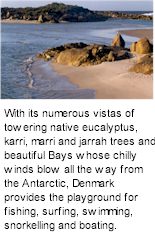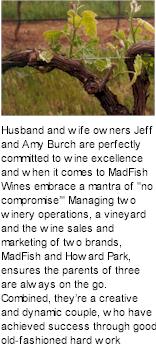


According to local folklore, the bay’s tranquillity is broken when two tides meet, resulting in schools of small fish going mad…. Jumping about to avoid being gobbled up by hungry, larger fish. MadFish, produced by Howard Park Wines, are wines with an emphasis on enjoyment and drinkability. They are for people who enjoy the pleasures of life: family, friends, food and wine.

Howard Park Wines first released the MadFish label in 1992 with the MadFish Premium White, soon followed by the MadFish Premium Red in 1993. Today they produce a number of styles, namely the much-lauded MadFish Chardonnay and Shiraz. These contemporary styles are made from cool climate fruit and are noted for their pure, fresh and clean characteristics in which the flavour of the fruit is the primary character.
As the story suggests, the MadFish name is derived from the magnificent MadFish Bay near the Howard Park Great Southern winery. The traditional aboriginal water turtle design on the label is a symbol of perseverance and tolerance – no doubt characteristics displayed by the poor fish in MadFish Bay who are constantly under attack by their predators. In the spirit of Western Australia, MadFish wines are without pretension and without fuss.
MadFish's locations, in the heart of the Great Southern and Margaret River, were chosen purposely to produce outstanding fruit. The sourcing of this fruit from specific vineyards, and in many cases specific blocks on the vineyard, is one of the most important factors in the production of MadFish wines.

During vintage, Chief Winemaker Michael Kerrigan drives over 26,000 kilometres testing, selecting and carefully monitoring the fruit planned for the MadFish range of wines. His trusty Holden Commodore wagon is constantly covered with dirt and mud from travelling the South West’s ‘dirt track’ roads. Amongst grape growers Michael has earn’t a reputation as bloody tough, rejecting more fruit than he accepts. The results speak for themselves.
MadFish Wines has been based at Denmark, a small coastal town located within Western Australia’s Great Southern region, since its inception in 1986. Home of MadFish Bay and situated 450 kilometres south of Perth, the coastline at Denmark and along to nearby Albany (50kms east) rates among the most beautiful in the South-West. Surrounded by spectacular Karri and Marri forest MadFish Wines’ Denmark Cellar Door is a place to welcome wine lovers and appreciators of natural beauty. Its 1000 tonne capacity winery is situated on an historical 100 acre property bound with native forest and accompanying kangaroos. MadFish's Margaret River winery and cellar door is located just outside the small town of Cowaramup, the birthplace thirty five years ago of what is now the Margaret River Wine Region. Named after Jeff Burch's (owner of MadFish Wines) late father, Leston Burch, the Leston Vineyard is the vine-producing property and home of MadFish Wines in Margaret River.
When purchased by Jeff and Amy Burch in 1988, the undulating, partly cleared land was an attractive but run-down sheep farm which was originally part of the West Australian Government Group Settlement Lots issued to pioneering families to develop agriculture in the Margaret River region in 1920's.
With an outlook to maintain the aesthetics of the natural environment, vineyard development began in 1995. The vision to create a showpiece vineyard incorporating best viticultural practices is now a reality with the first planting of vines occurring in 1996. The artwork for the label was originally designed by the late Maxine Fumagalli, a Noongar artist from Western Australia’s Great Southern. The traditional aboriginal water turtle design is a symbol of perserverance and tolerance - no doubt characteristics displayed by the fish in MadFish Bay.
